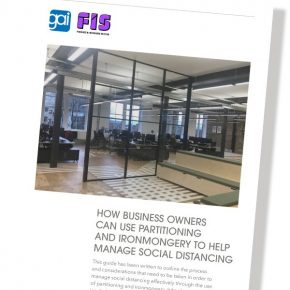
New guidance launched to help business owners manage workspace social distancing – GAI
A new guide that helps business owners understand the needs of its workforce and help plan safe working spaces has been created by two of Britain’s leading construction interior trade organisations, one being the GAI.
This guide will enable social distancing and help companies work effectively during the COVID-19 pandemic.
The ‘How Business Owners Can Use Partitioning and Ironmongery to Help Manage Social Distancing’ guide has been produced by the Guild of Architectural Ironmongers (GAI) and the Finishes and Interior Sector (FIS).
The guide, which calls for changes to the style and layout of traditional open plan offices and other workspaces as a result of the pandemic, provides practical guidance to help business owners understand key considerations they need to make when adapting their workplaces.
It aims to provide advice as to how to create the correct solution, addressing the issue of DIY screens that all too often fail to perform properly and can have unforeseen consequences with lighting, ventilation and even escape routes.
The GAI and FIS call the process re-cellularisation – the opposite to creating open plan spaces – and is intended to provide cellular space where social distancing can be provided, where teams can collaborate, and where individuals can find safe concentrated spaces when they are in the office.
Douglas Masterson, technical manager at the GAI, commented: “Within less than a year, Covid-19 has impacted every aspect of our lives. We’ve already seen big changes to the way that buildings operate, such as one way systems, and workplaces will need to continue to be responsive as new Government advice is released.
“Businesses need to protect staff, adhere to social distancing and maintain high standards of hygiene without compromising safety and security.
“This guide will be useful to employers who are looking for proactive solutions. It will help them to identify where measures should be implemented and the types of products that can deliver a safe and secure working environment.”
Implementing cellularisation using partitioning raises several questions about the considerations building owners need to make when it comes to choosing and installing partitioning systems as well as ironmongery products.
Performance considerations, including fire resistance of the partitioning and doors, reducing sound transmission and privacy, must also be considered along with the need for increased ventilation which has a substantial impact on reducing viral infections between occupants.
The guide also shows ways in which new partitions can look by using solid, glazed, part glazed and double glazed elevations, and adding blinds or manifestation which can reinforce a corporate identity or add images of outdoor landscapes to the space.
Joe Cilia, technical director at FIS, added: “We wanted to produce an accessible and useful guide that can be used by any business to understand how to approach the issue.
“The flow chart that we produced with the GAI is easy to follow and ensures that any unknown unknowns are dealt with.”
The guide discusses all aspects of partitioning and how employers can sub-divide working space to protect staff, including using the right ironmongery and how to reduce infection via touch points.
The guide can be downloaded via www.gai.org.uk/IndustryUpdates or www.thefis.org
Visit Supplier's page
Latest news

30th April 2025
Digital Construction Week announces seminar programme for its landmark 10th edition
Digital Construction Week (DCW) returns to ExCeL London on 4 – 5 June 2025 with its most impactful programme yet. It brings together the best and brightest from across AECO, for two days of practical learning and idea sharing.
Posted in Articles, Building Industry Events, Building Industry News, Building Products & Structures, Building Services, Building Systems, Exhibitions and Conferences, Information Technology, news, Restoration & Refurbishment, Retrofit & Renovation, Seminars
29th April 2025
Senior pledges to ‘bee’ part of the solution with new biodiversity initiative
Senior Architectural Systems has installed its first on-site beehive, marking another step forward in its commitment to sustainability and biodiversity.
Posted in Articles, Building Industry News, Building Products & Structures, Building Services, Curtain Walling, Doors, Glass, Glazing, Innovations & New Products, news, Restoration & Refurbishment, Retrofit & Renovation, Sustainability & Energy Efficiency, Walls, Windows
29th April 2025
West Fraser range delivering key benefits for South-East carpentry company
An experienced carpenter and building site manager who has recently set up his own company is using high performance panel products from the West Fraser range.
Posted in Articles, Building Industry News, Building Products & Structures, Building Systems, Case Studies, Garden, Restoration & Refurbishment, Retrofit & Renovation, Sustainability & Energy Efficiency, Timber Buildings and Timber Products
29th April 2025
CPD Courses Available Online From Ecological Building Systems
Ecological Building Systems, a leading supplier of natural building products for sustainable construction, has revealed its comprehensive CPD programme for the year ahead.
Posted in Articles, Building Industry Events, Building Industry News, Building Products & Structures, Building Services, Continuing Professional Development (CPD's), Information Technology, Innovations & New Products, Insulation, Restoration & Refurbishment, Retrofit & Renovation, Seminars, Sustainability & Energy Efficiency, Training, Walls, Waste Management & Recycling
 Sign up:
Sign up: